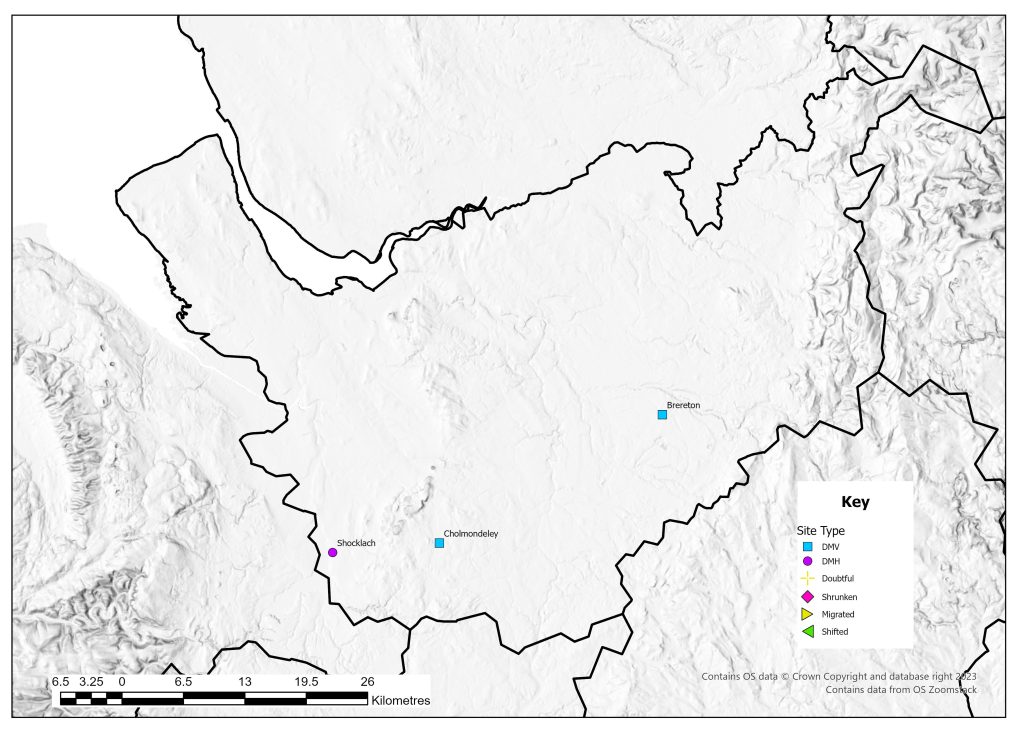
Description
In 1954 there were two sites listed with a possible further two (Beresford 1954: 345). One of the sites, Plemstall does not make it onto the Gazetteer in 1968. Only four settlements appear in the 1968 Gazetteer, with Ulure added. Cheshire is highlighted as one of the 15 counties which require considerable local research. Since this date a number of surveys have taken place as well as a consideration of the nature of settlement during the medieval period. In 1975 the MVRG noted that over the last four years much work had been undertaken with the documentary sources but that fieldwork needed to be done (Dyer 1975). Work by a number of individuals including D. Sylvester had noted the dispersed nature of settlement in a number of townships (Dyer 1975). It is now clear that this is a much more widespread pattern and that Cheshire as a whole had a great deal of dispersed settlement so the exact nature of the village and settlement make-up is difficult to reconstruct. Many of the settlements that become classed as deserted may not have been large nucleated entities in the first place. Many townships by the nineteenth century still contained no nucleated settlements (Edwards 2007). The main concentration of nucleated settlement in Cheshire is located to the west of the central Cheshire ridge (Dyer 1975).
Excavations
None of the sites have been excavated.
County Boundaries
Cheshire as a county has seen very few changes to its structure with only minor areas moving between adjacent counties pre-1974. Since this period many areas of conurbations have become Unitary Authorities and the County has become divided between Cheshire East and Cheshire West.
Documentary Evidence
The palatine of Cheshire was exempt from most medieval taxation so few records appear after the Domesday Book until the sixteenth century. In 1377 no writ was issued for the Poll Tax. In 1379 commissions were supposed to levy the tax, but this was cancelled and they were asked for an offer of aid instead (Fenwick 1998: xxi). The Crown confirmed the county’s immunity from parliamentary taxation in 1381 (Fenwick 1998: xxi). Again in the sixteenth century no lay subsidy was required in 1524, 1525 or 1543 (Sheail 1998: 3). Hence many of the entries on the website have been left blank. The 1563 Diocesan Return survives within the return for the Diocese of Chester (Dyer and Palliser 2005). With the dispersed nature of the settlement it can be difficult to disentangle the evidence for individual hamlets.
County Records
Although the County has been split into two authorities there is still a unified Cheshire county-based record for both the Historic Environment Record and the Local Archives. Both of these have online resources with the HER being accessible through Revealing Cheshire’s Past website and the Cheshire Archives having a wonderful website with access to the county Tithe Maps.
References
Beresford, M.W. 1954. The Lost Villages of England. London: Lutterworth Press.
Dyer, C. 1975. ‘Research in 1975: Cheshire’, Medieval Village Research Group Report 23: 7-10.
Edwards, R. 2007. The Cheshire Historic Landscape Characterisation Final Report. Cheshire County Council & English Heritage Unpublished Report.
Fenwick, C.C. 1998. The Poll Taxes of 1377, 1379 and 1381: Part 1: Bedfordshire-Leicestershire. Oxford: Oxford University Press.
Glasscock, R.E. 1975. The Lay Subsidy of 1334. London: Oxford University Press.
Sheail, J. 1998. The Regional Distribution of Wealth in England as Indicated in the 1524/5 Lay Subsidy Returns: Volume One. London: List and Index Society.
List of deserted villages recorded in 1968
Site names in italics are unlocated and so do not appear on the VIllage Explorer. For the unlocated sites, click on their names and it will take you to the basic information about this village.
- Brereton
- Cholmondeley
- Shocklach
- Ulure
